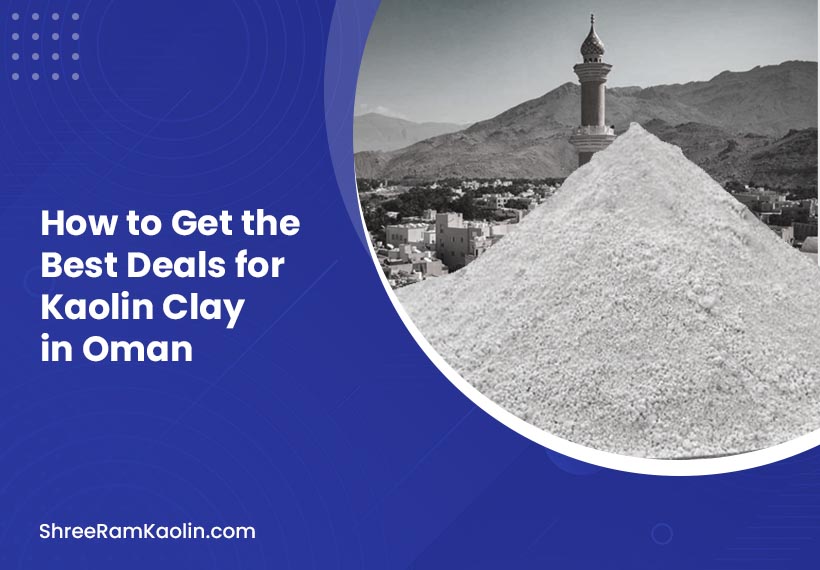Where to Buy and How to Get the Best Deals for Kaolin Clay in Oman?

Kaolin clay, a versatile mineral with myriad industrial applications, is abundant in Oman, presenting a lucrative opportunity for businesses and investors alike.
In this comprehensive guide, we delve into the nuances of Oman’s kaolin clay industry, exploring the types of industries, companies, factors to consider, and strategies for securing the best deals.
Understanding Oman’s Kaolin Clay Landscape
Traditional Kaolin Clay Industries
Oman boasts a rich history of traditional kaolin clay industries, often characterized by small-scale, family-owned businesses. These enterprises have honed their craft over generations, employing time-tested methods to extract and process kaolin clay.
Despite their smaller size, these businesses play a crucial role in preserving traditional techniques and contributing to Oman’s cultural heritage.
Modern Kaolin Clay Industries
In contrast, modern kaolin clay industries in Oman embrace cutting-edge technologies and large-scale operations. These companies leverage advanced extraction, processing, and distribution methods to meet the demands of a global market. With a focus on efficiency and quality, modern kaolin clay industries propel Oman onto the international stage as a significant supplier of this valuable mineral.
The Diverse Landscape of Kaolin Clay Companies in Oman
Oman’s kaolin clay sector comprises a diverse array of companies, each playing a unique role in the industry:
- Mining Companies: Responsible for the extraction of raw kaolin clay from Oman’s abundant deposits.
- Processing Companies: Specialize in refining raw kaolin clay into a market-ready form, adhering to strict quality standards.
- Trading Companies: Facilitate the buying and selling of kaolin clay, serving as intermediaries between producers and consumers, both domestically and internationally.
Navigating the Kaolin Clay Market: Tips and Step-by-Step Guide
Research Tips
- Begin by conducting thorough online research to identify key players and trends in Oman’s kaolin clay industry.
- Utilize industry reports, market analyses, and company profiles to gain insights into the market landscape.
- Attend trade shows, exhibitions, and industry events to network with industry professionals and gather firsthand information.
Step-by-Step Guide
- Define Your Requirements: Clearly outline your kaolin clay specifications, including quality, quantity, and budget constraints.
- Identify Potential Suppliers or Partners: Reach out to prospective companies via email or phone to express interest and request additional information.
- Conduct Site Visits and Meetings: Arrange visits or meetings with shortlisted companies to evaluate their capabilities, facilities, and adherence to quality standards.
- Negotiate Terms: Engage in negotiations regarding pricing, delivery schedules, and quality assurances to secure favorable terms.
- Finalize the Deal: Once terms are agreed upon, finalize the deal and establish a mutually beneficial relationship with the chosen supplier or partner.
Factors Influencing the Choice of Kaolin Clay Exporter in Oman

Geographical Considerations
- Proximity to Deposits: Opt for exporters situated near major kaolin clay deposits to minimize transportation costs and logistical complexities.
- Transportation Infrastructure: Ensure that the chosen exporter has access to reliable transportation infrastructure for seamless domestic and international shipping.
Political and Economic Factors
- Political Stability: Prioritize exporters operating in politically stable regions to mitigate the risk of supply chain disruptions.
- Economic Environment: Consider the broader economic landscape of Oman and its trading partners, as economic conditions can impact pricing and availability.
Evaluating the Pros and Cons of Oman’s Kaolin Clay Industry
Benefits of Investing or Partnering
- Abundant Natural Resources: Oman’s rich deposits of kaolin clay ensure a steady and sustainable supply of raw materials.
- Growing Market Demand: The increasing global demand for kaolin clay presents ample opportunities for growth and expansion within Oman’s industry.
- Supportive Government Policies: Oman’s government has implemented policies aimed at attracting foreign investment and fostering the development of the mining sector, providing a favorable business environment.
Challenges and Risks
- Competition from Other Suppliers: Oman faces competition from other countries producing kaolin clay, potentially affecting market share and pricing competitiveness.
- Infrastructure Limitations: Oman’s infrastructure, particularly transportation and logistics, may pose challenges for exporting kaolin clay to international markets.
- Regulatory Environment: Changes in regulations about mining and exporting kaolin clay in Oman could introduce uncertainties and impact business operations.
Conclusion
Oman’s kaolin clay industry presents a wealth of opportunities for those seeking to purchase kaolin clay or explore business ventures within the sector. By understanding the diverse landscape of traditional and modern industries, conducting thorough research, and considering key factors such as geographical, political, and economic considerations, stakeholders can navigate the market with confidence. With careful planning and strategic partnerships, businesses can capitalize on Oman’s abundant resources and establish a foothold in the global kaolin clay market.

